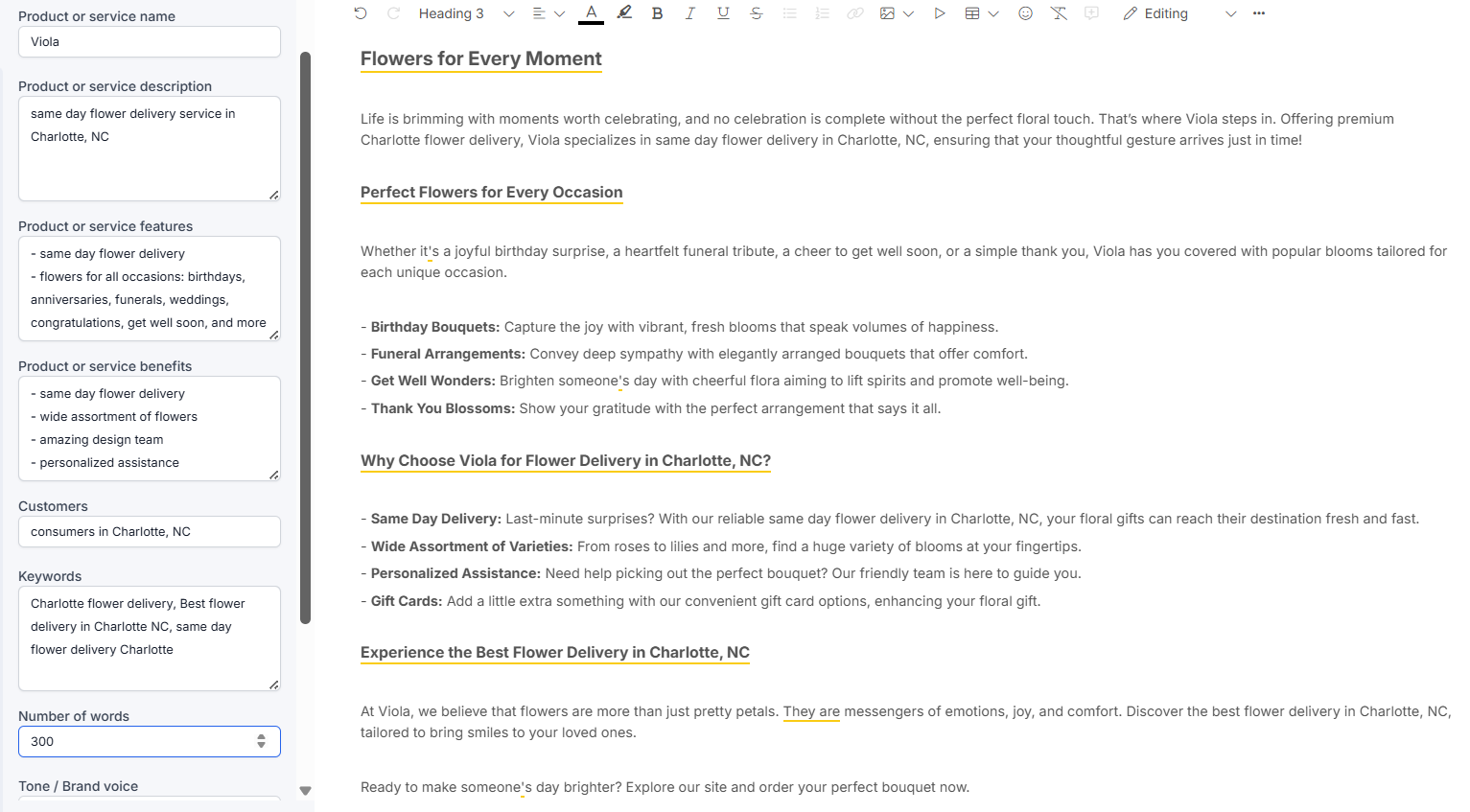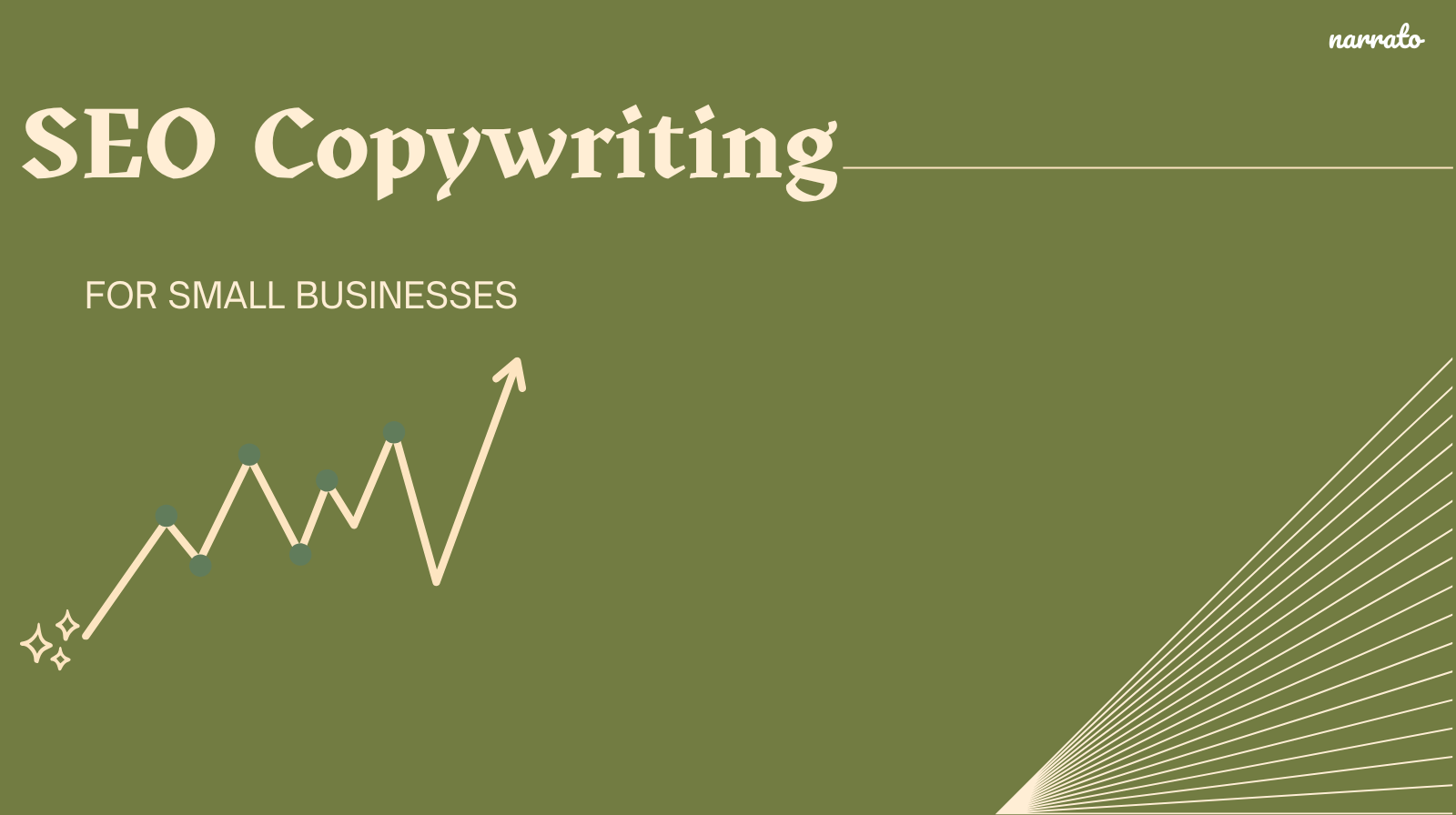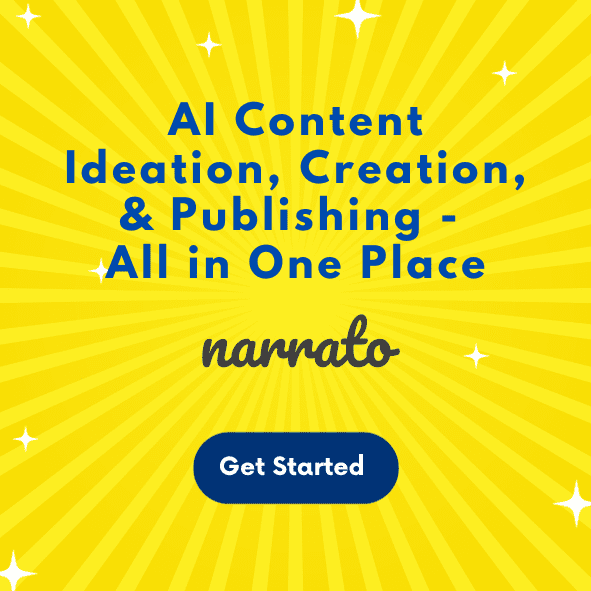If you’re on this page, you’ve probably decided to invest in an SEO strategy for your small business and want to know how to bring traffic to your website. In this post, we take you through the SEO tactics well-suited to your business size and the best practices that turn website visitors into leads. We’ll also talk about how AI can help with SEO copywriting, taking Narrato as an example.
What businesses can benefit most from SEO copywriting?
- Communicate well
- Match keywords to pages
- Integrate keywords naturally
- Optimize HTML tags
- Handle the technical side
How to use AI to create SEO copy

What businesses can benefit most from SEO copywriting?
Any business that’s online can benefit from SEO, including:
- E-commerce
- Restaurants
- Attorneys
- Insurance
- SaaS
- Auto repair
- HVAC
- Plumber
- Real estate
- Beauty salon
- Physicians
- Florists
- Education/Online learning platforms
- Gambling and sports betting
There’s no one magical strategy. You can also get results from paid marketing (Google and Meta Ads), organic social media, and traditional word-of-mouth-marketing. What worked really well for someone else may have a smaller effect for you. Trying a variety of content on a variety of platforms, and doing the right things — like getting your audience targeting right, providing good customer service, and measuring performance — will bring results, if not quickly, then in time. All the work you’d put in will bear fruit eventually.
On this note, let’s look at how to do SEO copywriting properly. But first, we’ll cover the basics just a little bit.
What is SEO copywriting?
SEO copywriting is a category of copywriting that focuses on increasing organic traffic with high-quality, keyword-optimized copy. It’s a process of implementing established SEO best practices, and making updates as required.
Examples of best practices are sharing quality content that matches user intent (informational, commercial, transactional) and ensuring fast page loading speeds. These are essential to the user experience, which Google considers crucial. Visitors will click away quickly from a landing page that has jargon-filled or unclear content, or that’s slow to load, which may hurt your rankings. Effective SEO copywriting addresses this by delivering clear, relevant, and engaging content that directly satisfies what users are searching for.
Updates to SEO landing or product pages happen when product features, pricing, or availability change, there are major shifts in market positioning, or conversion rates decline significantly. On the other hand, blog content gets more regular attention due to a few reasons. Search engines favor fresh, updated content for informational queries, and refreshing older posts with new information can improve rankings. Also, with the rise in LLM searches and AI Overviews, updating older posts with FAQs, direct answers to queries, and schema markup, can improve visibility.
How to create SEO copy?
To create effective SEO copy, focus on clear communication, strategic keyword use, and technical elements like meta tags and page structure. Let’s look at each in some detail.
Communicate well
- Make sure your copy is direct, focused, and easy to understand
- Talk to your audience’s needs and pain-points
- State your value clearly
- Guide action, like making a purchase, signing up for your newsletter, or contacting your team
- If you’ve defined a brand voice, use it consistently in your SEO copy to make your business more memorable and recognizable
- Include relevant images, GIFs, and videos to provide additional context, increase engagement, and improve user dwell time
- Use descriptive filenames and include relevant alt text to improve accessibility and provide context for search engines
Build trust with testimonials, awards, and data points. These various efforts help website visitors quickly understand if you have what they need and gives them concrete reasons to trust your business.
Match keywords to pages
There are four main types of keyword intent: informational (“how to file a patent”); navigational (“Amazon shipping policy”), commercial (“wedding flowers Charlotte NC”); and transactional (“same day flower delivery”). SEO copies for landing and product pages are optimized mainly for transactional, commercial, and navigational keywords as they’re likely to be used by those who’re far along in the buyer’s journey and ready to convert.
That said, you can also use different keyword types strategically across your site:
- Blog posts and guides: Target informational keywords to educate potential customers, then link to your commercial pages
- Landing and product pages: Focus on commercial and transactional keywords for higher conversion potential
- Advanced strategy: Incorporate specific, long-tail informational keywords into About and Service pages to capture additional search intents and create internal linking opportunities between your educational and commercial content.
Integrate keywords naturally
In copywriting, quality, clarity, and readability come first. But SEO copywriting must also consider keyword integration. A skilled copywriter should have no problem weaving key terms naturally throughout content. There are some best practices that are still relevant today, such as including the primary keyword in the first 100 words and in headings where they fit naturally, including related key terms and synonyms, and looking at semantic relevance, that is, building a meaningful context around the keyword.
To clarify:
If a page is about “best running shoes”:
Synonyms are sneakers, trainers, sports shoes, and others words/terms close in meaning to the primary keyword
Related keywords are stability, comfort, marathon, cushioning, Nike, Adidas, words or topics closely related to the main keyword but not necessarily interchangeable
Semantic relevance involves using related terms, synonyms, and conceptually linked keywords to help search engines get the full picture of and understand user intent behind the content. For “best running shoes”, semantic relevant content would mention relevant brands (Nike, Adidas, ASICS), shoe types (marathon, trail, road), buyer concerns (comfort, price, performance), and use cases (jogging, long-distance, sprint)
Optimize HTML tags
HTML elements help search engines understand your content and determine how it appears in search results. By optimizing key elements like title tags, meta descriptions, and URLs, you can improve your content’s visibility and click-through rates from search results.
- Title tags: Write interesting and unique title tags for each page that include your target keyword and keep within the character limit (50 to 60 characters, including spaces) to avoid getting truncated in search results.
- Meta descriptions: Same as above, with recommended length being 150-160 characters
- URLs: Create short, descriptive, and natural-sounding URLs that include your target keyword
Do technical SEO
Alongside writing great copy, pay attention to the technical elements of your website as they influence how search engines and users interact with your site. These are essential:
- Use XML sitemaps, robots.txt files to guide bots, and build a logical site architecture with clear internal linking. Search engines will more easily find, process, and index your pages.
- Build a fast-loading website. Common optimizations include compressing images, minimizing scripts, and using browser caching to improve load speeds for repeat visitors.
- Ensure a seamless experience on all devices, especially mobile as Google primarily uses the mobile version of a site’s content to index and rank pages in search results.
- Use schema markup to provide more context to search engines and help them understand your pages deeply, which can increase chances of featuring in rich snippets in search results.
- Remove duplicate content to prevent search engines from getting confused and diluting your site’s ranking power across multiple similar URLs.
- Use an HTTPS URL to show visitors and search engines that your site is secure.
How to use AI to create SEO copy
In today’s climate of increasing skepticism, people are more wary of businesses, which means you might have to work harder to show your credibility and commitment. Your website is one of the first touchpoints people have with your brand, especially for those discovering you for the first time. A professional website that people can explore easily and lays out your value in clear terms builds initial trust and gives you an advantage.
But creating and updating website copy takes significant time that small business owners often don’t have. While a website design agency can handle this work, you might prefer making updates yourself — if your website platform allows it. Partnering with experts in B2B website design ensures your site is strategically built to attract the right audience, highlight your value, and support long-term business growth. If you’ve basic technical knowledge of HTML and CSS, you may be able to handle website updates on your own. This is where AI becomes particularly valuable, helping you generate new pages or refresh existing content with keyword-optimized copy quickly.
SEO copywriting using Narrato
Narrato is an AI assistant creating different types of marketing content for small businesses that want to scale their websites and manage their content needs self-sufficiently. Like popular generative search engines, it can write web copy within seconds. It also offers SEO features that analyze the content for user experience and optimization, like keyword additions, USPs, audience targeting, and tone of voice.

Copy generated by AI lacks the emotion a skilled copywriter can bring. What AI does well is to create clear, logically structured, grammatically sound, and — depending on how good it is — engaging copy that reads well and makes a good impression. But you want more than that, so make sure to review what AI creates and add the human touch and insights wherever they’re missing in the copy.
AI grasps your instructions and creates or edits in a flash. The more you work with AI — learning its strengths and understanding its quirks — the better you’ll become at guiding it to create highly effective copy. This is especially the case when you’re using AI agents that use your prompts as direction to do what they do best, like create tailored ads, long-form blogs, webpages, metadata, videos, images, or social posts. Simple prompts are also at the heart of content generated at enterprise-scale, as seen with AI marketing platform Typeface, which creates content grounded in your owned data, and within the constraints of your templates and voices.
Try Narrato for free
Narrato’s large variety of AI content templates (blogs, social media posts, product descriptions, email, ads, and more), and flexible plans suit the needs of SMBs. Check for fit with a free trial.





